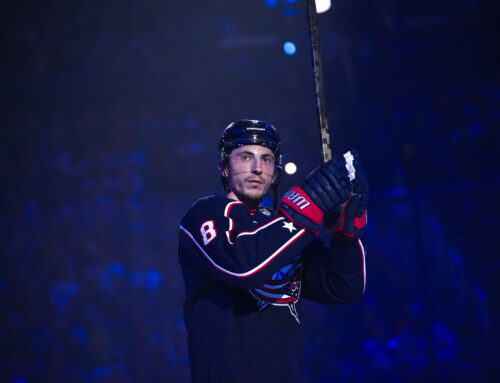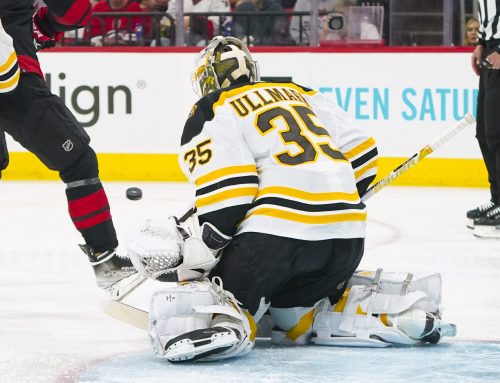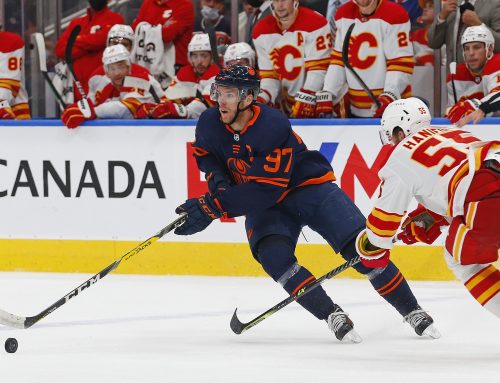
A closer look at what is ahead for the National Hockey League salary cap after expansion …
The NHL’s expansion plans are hardly a secret to the hockey world. Expansion applications were sent out just recently, and the NHL has received two submissions: one from Quebec City and one from Las Vegas. They’ve done this before, so most people are semi-familiar with expansion drafts and the implications of expansion on scoring. More teams means talent gets more spread out, and the expansion teams get bullied into oblivion by other, better teams. At least for the first few seasons post-expansion. Scoring goes up a tick, everyone’s happy. Well, almost everyone.
However, this is the first time in 15 years that the NHL has done this and the first time in the salary cap era. The implications of expansion on the cap have yet to be observed, but that doesn’t mean we can’t predict them.
To begin, we’ll need to look at how the cap is currently calculated.
The Formula
The league throws a bunch of really good guesses together of how much hockey-related revenue (HRR) they’re expecting to expect to generate in the coming season and then takes the “midpoint” of these projections for cap calculation. The owners receive 50% of HRR and the players receive the other 50%, as per the CBA, so right away, let’s cut that number in half. The players’ share then gets split between all the teams. The NHLPA can raise this number by 5%, and the cap is set 15% above that number after all these calculations.
Whew. What a mouthful. I’ve put together a formula to make it easier to visualize.

For example, given these 3 projections of HRR:
1)$3.8B
2)$3.2B
3)$3.6B
The average is $3.53B, which we can put through our formula and…

The important part here is for every team to contribute to HRR equally. If a team doesn’t, the cap will fall. Each team is responsible for generating 1/30th of the projected HRR in order to maintain the cap. Any more, and the cap goes up. Any less, and the cap goes down. In our example, that means about $117 million.
This formula has only two variables: the salary cap and HRR. If we have one, we can calculate the other. Using the salary cap data from the past (I’ve done that already), here are the results:

What does this mean for the cap?
Well for one, the earliest time the NHL will be ready for expansion, according to NHL Assistant Commissioner Bill Daly, is the 2017-18 season. Using the average rate of increase for the past three years, I’ve predicted a total HRR of approximately $3.86 billion for that season. Because each team must contribute 1/30th of the $3.86B HRR, this means each team should be generating about $128,740,000 in 2017-18.
If the NHLPA uses their 5% escalator, this would mean the cap in 2018 will be about $77,726,775. That’s a lot higher than what it is now, enough to fit in a Vladimir Tarasenko or Phil Kessel! NHL General Managers love to sign players to pretty expensive deals with the hopes that this exact situation happens. This would mean that those big cap hits take up a smaller percentage of the cap as time goes on.
For example, Toews and Kane’s $10.5M cap hit represents 14.7% of the 2016 cap, but will only represent 13.5% of my projected 2017-18 cap, and 13% of the 2018-19 cap. These deals become much less painful as time goes on. For example, in 2015-16, 13% would be a cap hit of just $8,958,120, over $1.5M in savings.
This is how the cap projects, over the same time period. The big drop is when the players’ share of HRR dropped from 57% to 50% as part of the new CBA:

The Problem
Once expansion rolls around (we’ll use 2017-18 for our example), the NHL needs an additional $257,480,000 in revenue to maintain that cap. After all, HRR will now be split 32 ways, instead of just 30. Can the expansion teams provide that? The only two locations that submitted applications are Quebec City and Las Vegas. The best comparable franchises, in my opinion, are Winnipeg (a returning Canadian franchise) and Arizona (a desert-based non-traditional market without a large ticket-holding fanbase).
Finding the NHL’s real HRR statistics is next to impossible (otherwise I wouldn’t have to calculate it for previous years), but Tyler Dellow of mc79hockey.com released numbers for the Blue Jackets’ 2006 HRR ($57.4M), which represented 82% of their total revenue ($66M, as listed by Forbes). Together, Arizona and Winnipeg made $182 million last year, so 82% (the ratio of revenue that is hockey related, for the Blue Jackets at least) of that is $150,839,393.
This means that the Quebec Nordiques and the Las Vegas Mumps are likely to raise about that much if they hit the ground running. Very bad news. They’re almost $100 million short of their target, and that’s without considering growing pains! If they generate ¾ of the revenue of the Jets/Coyotes, it’ll be just $113,129,544. Even worse news! But let’s assume best-case scenario, because optimism!
Here’s what the cap will look like in the coming expansion years, given the numbers we’ve used so far:


The Bottom Line
Expansion is going to drag the cap down like crazy. In 2017-18, it could be lowered as much as $2,000,000! Well, maybe not lowered, but it’ll certainly prevent it from growing by very much at all. And the bad news doesn’t end there. The longer the NHL delays expansion, the more that HRR grows, which means each team is responsible for generating more and more money. This in turn means that Quebec and Las Vegas will need to generate even more, just to keep the “salary cap drop” at $2,000,000. General Managers who are expecting the cap to grow and signing players with that in mind will be taken by surprise, just like in the 2014-15 season, where the cap was expected to be north of $71M, but only grew to $69M.
Which GMs? That’ll depend on the capologist they’ve got on payroll. You better hope your team’s got a good one.
7 Comments
Leave A Comment
You must be logged in to post a comment.






 ANA
ANA UTA
UTA MIN
MIN CAR
CAR MTL
MTL NYI
NYI VGK
VGK DET
DET SEA
SEA

Excellent read. I’ve never cared to look so deeply into how the cap is evaluated.
One issue I see with this… lower income teams with team budgets, aren’t exactly encouraged to make more money (yes I’m aware that every teams goal should be to make as much money as possible). They keep the cap lower which keeps their team more competitive. I assume this is countered by the higher income teams. Making more money, raising the cap.
Thoughts?
You’re saying that a team shouldn’t earn an extra dollar because then it raises the amount that every team is expected to spend by 3 cents.
My thought is that doesn’t make sense.
They don’t want to SPEND money because they don’t HAVE money. The higher the salary FLOOR goes, the more they have to spend. The salary CAP going higher certainly hurts them and their ability to compete, but the more money they make, the more they can afford to pay players. The more they can afford to pay players, the more they can compete. Cory makes a very good point as well. They’re giving Toronto and NYR the chance to spend 3 extra cents, while they get a whole dollar.
Much of the time a team salary budget is set without regard to actual capability to pay that much, but rather is set as an maximum budgeted expense line, so that a certain profit level happens for the owners/shareholders.
You will often find companies moving money around between affiliated corporations to avoid giving more of a share to employees, governments, and in the case of sports with revenue sharing, their players and other teams they have to play. It’s one reason teams like owning stakes in buildings, concessions, sports, networks, etc. Lots of way to play games with the numbers.
This is an excellent article, a great read.
My league uses the NHL cap to set our active lineup salary cap. Earlier in the year I heard that the cap would be rising to $75M, but then lately I’d heard some rumours that the cap wasn’t going to rise much at all, if anything.
Is the predicted HRR for next year just based on the historical trend, or is it based on more concrete current data?
Historical trend. I wish I could make accurate projections, but the
amount of money the players lose to escrow just highlights the fact that
even the *NHL* has no idea how much HRR will increase (or not!)
Great article!! I think this explains why Bettman has always hinted about expanding one team at a time. So many people are saying teams won’t leave the $500M expansion fee on the table to accept relocation for LV or Quebec. With what you wrote, now we understand why the league doesn’t just accept any teams who are willing to fork up the expansion fees $$$.
I think if NHL accepts Vegas’ expansion, and simply relocate a team currently low on HRR to Quebec. Divide the sum of what Vegas can make and the improvement of Quebec from said weak team, over 31 teams instead 32, Cap might bot be affected as much?